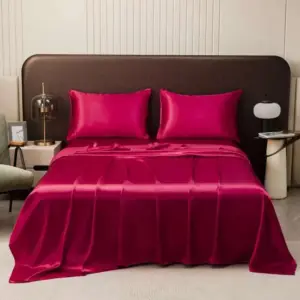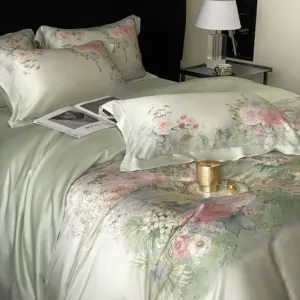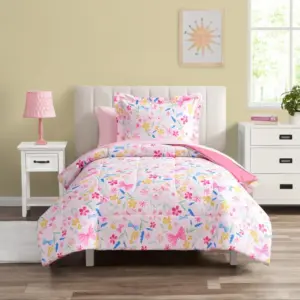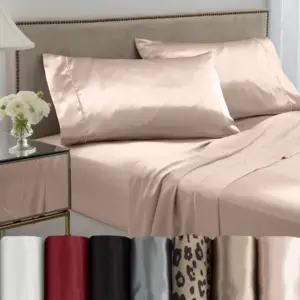Introduction
Hypoallergenic fabrics are materials specifically designed or naturally occurring that are less likely to trigger allergic reactions. These fabrics minimize irritation through their fiber structure, reduced chemical processing, and natural properties that resist common allergens. With approximately 30% of adults and 40% of children experiencing sensitive skin conditions, the demand for natural hypoallergenic textiles has grown significantly in recent years.
Natural hypoallergenic fabrics have become increasingly important as more people recognize the connection between synthetic materials and skin irritation. The unique properties of certain plant and animal fibers—their breathability, smooth texture, and minimal chemical processing—make them ideal choices for those with allergies, eczema, asthma, or generally sensitive skin.
The right fabric can make a tremendous difference not just for comfort but for overall health and wellness. When we sleep on hypoallergenic properties silk fabric, we’re not just enjoying luxury—we’re creating an environment that supports better respiratory health and skin condition throughout the night.
In this guide, we’ll explore several exceptional natural fabrics including organic cotton, linen, hemp, silk, bamboo lyocell, and select wools, examining what makes them truly hypoallergenic and how to choose the most hypoallergenic fabric for your specific needs.
What Defines a Truly Hypoallergenic Fabric
Understanding what makes a fabric truly hypoallergenic requires looking at several key characteristics that work together to reduce allergic reactions and skin irritation:
Fiber structure: Smooth, long fibers with minimal protruding ends cause less mechanical irritation against the skin. Fabrics with rough textures or short fibers that stick out can physically irritate sensitive skin and trigger reactions.
Breathability: Fabrics that allow air to flow freely create a less hospitable environment for allergen growth. This ventilation prevents the warm, damp conditions that dust mites and other allergens thrive in.
Moisture management: Materials that efficiently wick moisture away from the body help maintain dry conditions that discourage bacterial growth and dust mite proliferation. Dust mites—which trigger up to 80% of allergy sufferers’ reactions—require humidity above 50% to survive and reproduce.
Natural resistance: Some fibers naturally contain properties that resist common allergens like dust mites, mold, and mildew without requiring chemical treatments.
Minimal chemical processing: Fabrics that require fewer chemicals during production or are processed using gentler methods carry fewer residual irritants that might trigger sensitivities.
Tight weave structure: While maintaining breathability, a tighter weave can physically block larger allergen particles from penetrating the fabric, creating a natural barrier.
The what makes silk hypoallergenic qualities become particularly apparent when examining fiber structure under a microscope. Natural hypoallergenic fibers typically show smooth, consistent surfaces compared to synthetic or lower-quality natural fibers that may have irregular surfaces that trap allergens and irritate skin.
Important Certifications for Hypoallergenic Fabrics
When shopping for truly hypoallergenic fabrics, certain certifications can help verify a product’s claims and ensure you’re getting genuine hypoallergenic benefits:
OEKO-TEX Standard 100: This comprehensive certification tests for harmful substances at all processing stages. Products must pass rigorous testing for over 100 harmful substances, including pesticides, heavy metals, formaldehyde, and allergenic dyes. The certification ensures that every component—from threads to buttons—meets strict safety standards.
Global Organic Textile Standard (GOTS): GOTS certification covers the entire production process from harvesting raw materials through manufacturing to labeling. It ensures that textiles contain a minimum of 70% organic fibers and meet environmental and social criteria along the production chain.
USDA Organic: In the United States, this certification verifies that raw materials are grown without prohibited substances like most synthetic pesticides and fertilizers for at least three years prior to harvest.
Woolmark: Specifically for wool products, this certification guarantees quality wool that meets specific standards for fiber quality, performance, and production methods.
Fair Trade: While primarily focused on ethical labor practices, Fair Trade certified products often involve less intensive chemical processing, which can correlate with fewer potential irritants.
When examining product labels, look for these certification logos or explicit mentions of these standards in product descriptions. These certifications provide valuable assurance that the certified hypoallergenic pillowcases and other bedding items you’re considering have been independently verified for their hypoallergenic claims.
Organic Cotton: The Gentle Classic
Organic cotton stands apart from conventional cotton through its pesticide-free and chemical-free growing process. Conventional cotton is one of the most chemically-treated crops globally, potentially containing residues from up to 16 different pesticides even after processing. Organic cotton eliminates these potential irritants from the start.
The hypoallergenic properties of organic cotton include:
- Natural softness that becomes even softer with washing
- Superior breathability allowing air circulation and moisture evaporation
- Excellent absorbency that wicks moisture away from the skin
- Chemical-free production reducing potential irritants
Different varieties offer unique benefits:
– Pima cotton: Extra-long staple fibers create an exceptionally smooth fabric with minimal protruding ends to irritate skin
– Egyptian cotton: Known for its luxurious feel and durability, with a particularly fine and smooth texture
For optimal comfort and hypoallergenic benefits, look for organic cotton bedding with a thread count between 300-400, which balances breathability with smoothness. Higher thread counts can sometimes trap heat and reduce the natural breathability that makes cotton hypoallergenic.
To maintain the hypoallergenic properties of organic cotton:
– Wash in warm (not hot) water with mild, fragrance-free detergent
– Avoid fabric softeners which can leave irritating residues
– Dry completely before storing to prevent mildew growth
While organic cotton provides excellent hypoallergenic benefits, those seeking the ultimate in smooth fiber texture might consider 100% silk sheets as an alternative that offers additional benefits for sensitive skin.
Linen: Ancient Fiber with Modern Benefits
Derived from the flax plant, linen is one of the oldest textile fibers in human history, prized for thousands of years for its exceptional properties. This ancient fabric requires minimal chemical processing to transform from plant to fabric, making it naturally low in potential irritants.
Linen’s remarkable hypoallergenic qualities stem from several distinctive properties:
Linen can absorb up to 20% of its weight in moisture while still feeling dry to the touch. This exceptional moisture-wicking ability prevents the damp conditions that allow dust mites and bacteria to thrive, making it particularly suitable for those with respiratory allergies.
The fabric’s natural structure creates exceptional breathability, allowing continuous airflow that keeps skin cool and dry. This breathability, combined with the fabric’s inherent resistance to bacteria and microbes, makes linen an excellent choice for allergy sufferers.
Though linen starts with a distinctive crisp texture, it gradually softens with each washing while maintaining its structural integrity. This evolution creates a fabric that becomes increasingly comfortable while retaining its hypoallergenic benefits.
Perhaps most impressively, linen offers natural thermoregulating properties that adjust to body temperature—cooling in summer and providing warmth in winter—making it ideal for year-round comfort and reducing the need for additional bedding that might harbor allergens.
The sustainability aspects of flax cultivation add another benefit—the plant requires minimal water and pesticides to grow, reducing the overall environmental impact and chemical exposure throughout the production process.
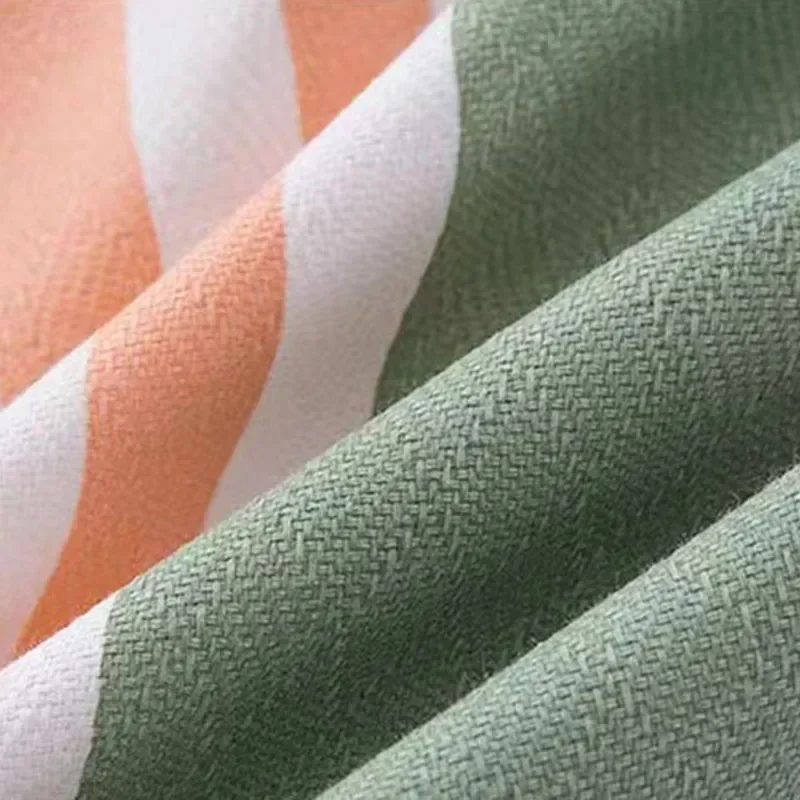
For those seeking comprehensive solutions beyond just fabric choice, exploring best hypoallergenic bedding complete guide options can help create an allergy-friendly sleep environment.
Hemp: The Sustainable Allergen Fighter
Hemp fabric represents one of the most naturally hypoallergenic and environmentally friendly textile options available. The cannabis sativa plant (industrial hemp) naturally resists pests during cultivation, eliminating the need for pesticides that can leave irritating residues in the finished fabric.
What makes hemp exceptionally suitable for sensitive skin:
Hemp’s natural resistance to bacteria, mold, and mildew is unmatched among natural fibers. These properties make it particularly beneficial for allergy sufferers and those with respiratory sensitivities, as it naturally prevents the growth of common allergen-producing organisms.
The durability of hemp stands out compared to other natural fibers—it’s approximately three times stronger than cotton and becomes softer with each wash without losing structural integrity. This longevity means fewer replacement cycles and less exposure to potential manufacturing chemicals over time.
From an environmental perspective, hemp requires minimal water for cultivation and naturally improves soil health, making it one of the most sustainable fabric options available. Hemp can yield 250% more fiber than cotton on the same land area with significantly fewer resources.
Additional benefits include hemp’s ability to block up to 95% of UV rays naturally, adding protection for sensitive skin when used in clothing. The fiber’s porous nature also contributes to excellent temperature regulation, keeping you cool in summer and warm in winter.
While hemp starts with a texture that some compare to rough linen, modern processing techniques and repeated washing result in a fabric that becomes increasingly soft while maintaining its hypoallergenic properties. For those seeking alternatives with immediate softness, silk sheets offer another excellent hypoallergenic option.
Silk: Nature’s Luxury Hypoallergenic Fiber
Silk stands apart from plant-based hypoallergenic fabrics through its unique protein-based fiber structure. These natural protein fibers consist primarily of amino acids that closely resemble those in human skin, creating exceptional biocompatibility that minimizes irritation even for extremely sensitive individuals.
The smooth, tightly woven structure of silk creates a natural barrier that keeps dust mites, mold, and mildew at bay. Unlike cotton and other plant fibers that can harbor these common allergens, silk’s microscopic structure provides fewer places for irritants to hide.
Mulberry silk represents the highest quality silk available, comprising over 90% of global silk production. The exceptionally long fibers in mulberry silk—up to 3,000 feet per cocoon—create a smoother texture with fewer potential irritation points than shorter-fiber varieties.
When evaluating silk quality, momme weight (similar to thread count) becomes crucial. The optimal range of 19-25 momme provides the perfect balance between luxurious feel and durability. This weight range ensures sufficient density to block allergens while maintaining the breathability that makes silk hypoallergenic.
The temperature-regulating properties of silk add another layer of benefit for allergy sufferers. By maintaining an optimal microclimate next to the skin—cooling in summer and insulating in winter—silk reduces sweating and moisture buildup that can exacerbate skin sensitivities.
Silk naturally contains 18 amino acids and proteins similar to those found in human skin. These compounds work with the fabric’s moisture-wicking properties to help maintain skin hydration balance, potentially reducing symptoms for those with eczema or extremely dry skin.
For specific information about how these properties benefit allergy sufferers, exploring resources on silk bedding allergy sufferers can provide deeper insights. Those ready to experience premium hypoallergenic benefits can browse mulberry silk sheets options in the ideal momme weight range.
Bamboo Lyocell: The Eco-Friendly Alternative
Bamboo lyocell represents a significant advancement in eco-friendly hypoallergenic fabrics, offering many benefits similar to silk with different environmental credentials. When considering bamboo-derived fabrics, it’s crucial to distinguish between different processing methods that yield dramatically different results.
The distinction between bamboo viscose/rayon and bamboo lyocell is significant. While both start with the same plant material, traditional viscose processing uses harsh chemicals that may leave residues in the final fabric. In contrast, lyocell processing employs a closed-loop system that recycles 99% of the non-toxic solvents used, resulting in a cleaner, more hypoallergenic final product.
The bamboo plant contains a natural antimicrobial agent called “bamboo kun” that helps the plant resist pests and fungi in nature. When properly processed into lyocell, some of these beneficial properties are retained in the final fabric, offering natural protection against bacteria and dust mites without added chemicals.
The exceptionally soft texture of bamboo lyocell rivals high-end fabrics like silk, creating a smooth surface that minimizes mechanical irritation against sensitive skin. This silky softness combines with excellent breathability and moisture-wicking properties to create an ideal microclimate for sensitive skin.
From a sustainability perspective, bamboo grows remarkably quickly—up to 3 feet in 24 hours—making it one of the most renewable plant sources available. It requires minimal water, no pesticides, and can be harvested without killing the plant, further reducing environmental impact.
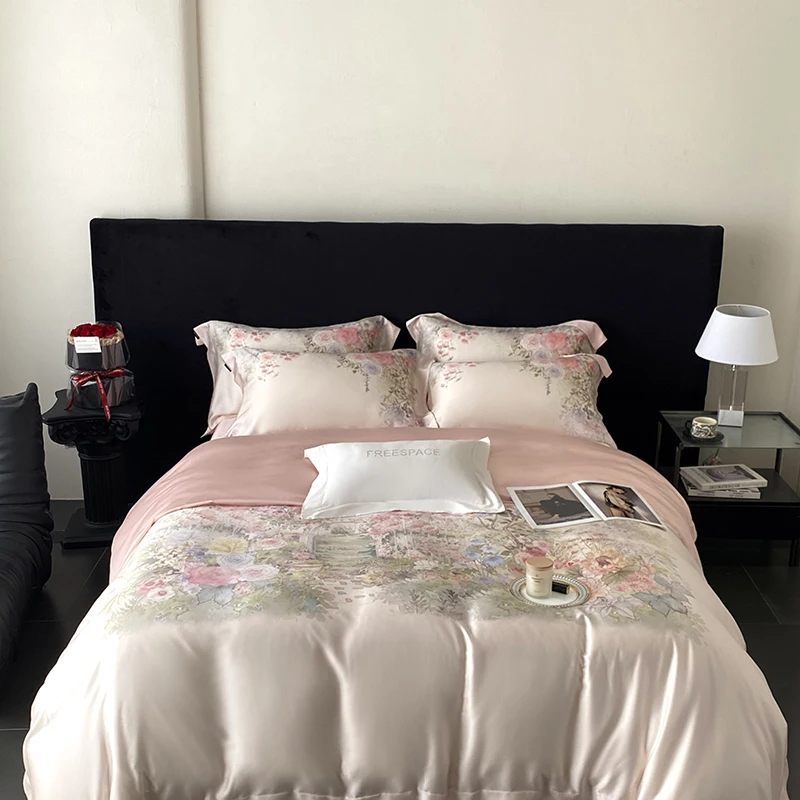
Those interested in comparing different hypoallergenic options might find the detailed analysis in bamboo vs mulberry silk fabric helpful for making an informed decision. For those seeking eco-friendly alternatives to animal-derived fabrics, vegan silk bedding provides excellent hypoallergenic options with environmental benefits.
Merino and Alpaca Wool: Fine Fibers for Sensitive Skin
Many people mistakenly believe all wool causes skin irritation, but the reality is more nuanced. The key differentiator between irritating and hypoallergenic wool is fiber diameter—measured in microns (μm). Traditional wool fibers measure 25+ microns in diameter with scaly surfaces that can trigger mechanical irritation against sensitive skin.
In contrast, fine wools like merino and alpaca feature significantly thinner fibers—often between 15-20 microns for premium merino and 17-24 microns for alpaca. These finer diameters create smoother surfaces against the skin, dramatically reducing the scratchy sensation associated with conventional wool.
Beyond fiber diameter, these premium wools offer exceptional temperature regulation properties. The natural crimp in the fibers creates tiny air pockets that provide insulation in cold weather while allowing heat and moisture to escape in warmer conditions. This natural breathability helps maintain dry conditions that discourage dust mites and bacteria.
One remarkable property of fine wool is its ability to absorb up to 30% of its weight in moisture without feeling wet. This moisture-wicking capability helps maintain dry skin conditions while naturally resisting odor-causing bacteria—even with less frequent washing than other fabrics require.
Lanolin, the natural wax produced by wool-bearing animals, presents an interesting consideration for hypoallergenic properties. While properly cleaned wool retains small amounts of lanolin that benefit most people’s skin, some individuals may be sensitive specifically to this compound. High-quality processing can reduce lanolin content for those with specific sensitivities.
For people with extremely sensitive skin looking for alternatives to wool, learning about natural silk properties sensitive skin can provide valuable information about other hypoallergenic options.
Comparing Natural Hypoallergenic Fabrics: Which Is Best for You?
When selecting the ideal hypoallergenic fabric for your needs, consider how each option performs across key factors that impact comfort, allergies, and practical use:
| Fabric | Softness | Breathability | Moisture-Wicking | Allergen Resistance | Temperature Regulation | Durability | Care Difficulty | Sustainability | Price Range |
|---|---|---|---|---|---|---|---|---|---|
| Organic Cotton | 4/5 | 4/5 | 3/5 | 3/5 | 3/5 | 3/5 | 2/5 | 4/5 | $$ |
| Linen | 3/5 | 5/5 | 5/5 | 4/5 | 5/5 | 5/5 | 3/5 | 5/5 | $$$ |
| Hemp | 3/5 | 4/5 | 4/5 | 5/5 | 4/5 | 5/5 | 3/5 | 5/5 | $$$ |
| Mulberry Silk | 5/5 | 4/5 | 4/5 | 5/5 | 5/5 | 4/5 | 4/5 | 3/5 | $$$$ |
| Bamboo Lyocell | 5/5 | 4/5 | 5/5 | 4/5 | 4/5 | 3/5 | 3/5 | 4/5 | $$$ |
| Merino Wool | 4/5 | 5/5 | 5/5 | 4/5 | 5/5 | 4/5 | 4/5 | 4/5 | $$$$ |
For extremely sensitive skin: Mulberry silk and bamboo lyocell offer the smoothest textures with fewest irritation points, making them ideal for those with eczema or dermatitis.
For hot sleepers: Linen provides unmatched breathability and moisture-wicking, creating a consistently cool and dry sleep environment.
For year-round comfort: Merino wool and silk excel at temperature regulation, adapting to both warm and cool conditions naturally.
For durability and value: Hemp and linen offer exceptional longevity, becoming softer with each wash while maintaining structural integrity for years.
For eco-conscious shoppers: Hemp and linen require minimal water and pesticides during cultivation, while bamboo lyocell (not viscose) offers sustainable processing methods.
For ease of care: Organic cotton offers the simplest maintenance, with standard washing and drying requirements that most households can easily accommodate.
Health Benefits of Natural Hypoallergenic Fabrics
Switching to natural hypoallergenic fabrics can provide significant health benefits beyond basic comfort:
• Reduced skin irritation: Natural fibers with smooth surfaces minimize friction against skin, decreasing redness, itching, and rashes that can disrupt sleep and daily comfort.
• Better respiratory health: Fabrics that naturally resist dust mites, mold, and mildew can significantly reduce nighttime symptoms for asthma and allergy sufferers, particularly important since we spend approximately one-third of our lives in bed.
• Improved sleep quality: Temperature-regulating fabrics like silk and wool help maintain optimal body temperature throughout the night, reducing sleep disruptions from overheating or chilling that can fragment sleep cycles.
• Decreased chemical exposure: Natural fabrics processed without harsh chemicals reduce the toxic burden on sensitive individuals, particularly beneficial for those with multiple chemical sensitivities who may react to conventional fabric treatments.
• Enhanced skin healing: Smooth, breathable fabrics reduce further irritation of already compromised skin, potentially accelerating healing for those with eczema, psoriasis, or contact dermatitis.
• Long-term skin health preservation: Reduced friction and irritation may help maintain skin barrier function over time, potentially slowing visible aging processes and maintaining healthier skin.
Clinical studies have demonstrated that participants using natural fiber bedding experience measurably improved sleep quality with fewer nighttime disturbances compared to those using synthetic alternatives.
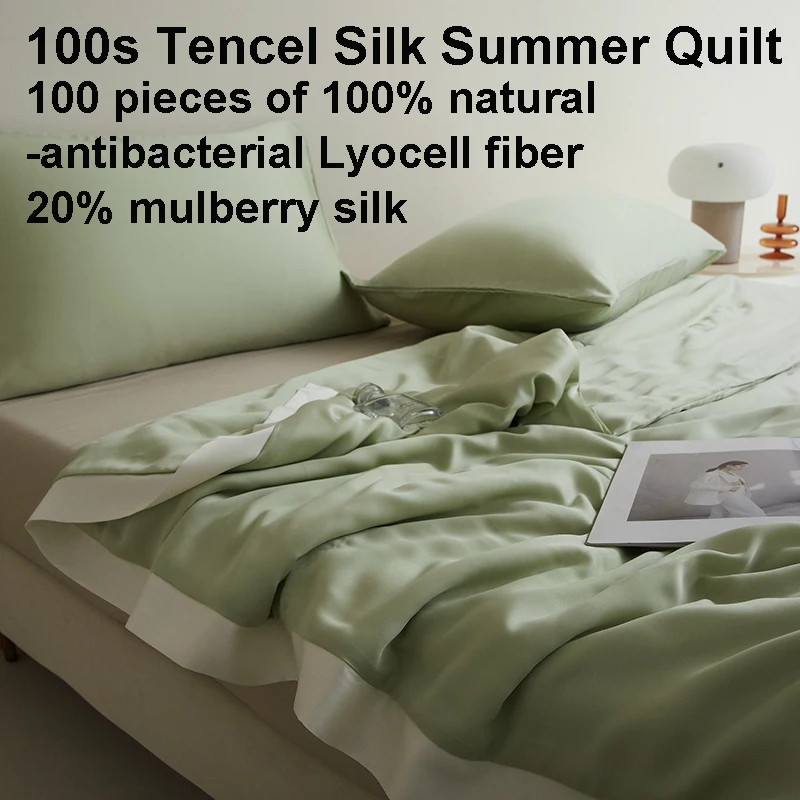
For deeper insights into specific benefits of silk bedding, exploring the hypoallergenic features silk sheets can provide valuable information about this premium option.
Full-size Silk Sheets, King Size Silk Sheets, Queen Size Silk Sheets, Twin Size Silk Sheets, Washable Silk Sheets
Price range: $95.95 through $178.37 Select options This product has multiple variants. The options may be chosen on the product page100% Silk Sheets, Green Silk Sheets, King Size Silk Bedding Set, Mulberry Silk Bedding Sets, Queen Size Silk Bedding Set
Price range: $1,246.21 through $1,615.22 Select options This product has multiple variants. The options may be chosen on the product pageEucalyptus Silk Bedding Sets, Eucalyptus Silk Sheets
Price range: $360.24 through $393.60 Select options This product has multiple variants. The options may be chosen on the product pagePink Silk Sheets, Twin Size Silk Sheets
$171.80 Select options This product has multiple variants. The options may be chosen on the product pageFull-size Silk Sheets, Pink Silk Sheets
$136.31 Select options This product has multiple variants. The options may be chosen on the product pageGrey Silk Sheets, Silk Sheet and Pillowcase Set
Price range: $88.20 through $146.64 Select options This product has multiple variants. The options may be chosen on the product page
How to Care for Your Natural Hypoallergenic Fabrics
Proper maintenance is essential for preserving the hypoallergenic qualities of natural fabrics:
General care principles:
1. Wash new items before first use to remove any processing residues
2. Follow temperature guidelines specific to each fabric type
3. Use fragrance-free, hypoallergenic detergents
4. Avoid fabric softeners and dryer sheets, which leave residues that can irritate skin
5. Store completely dry to prevent mildew growth
Fabric-specific guidelines:
For cotton: Machine wash in warm water (not hot) and tumble dry on medium. Hot water can damage fibers and reduce softness over time.
For linen: Machine wash in cool to warm water. Line drying maintains fiber integrity, though tumble drying on low heat is acceptable for softer results.
For silk: Hand wash in cool water with specialty silk detergent or on the delicate cycle in mesh laundry bags. Air dry away from direct sunlight to prevent yellowing.
For bamboo lyocell: Wash in cold water on gentle cycle. Air dry or tumble dry on lowest heat setting to prevent shrinkage.
For wool: Use wool-specific detergents that preserve lanolin. Cold water washing and air drying prevent shrinkage and fiber damage.
Recommended hypoallergenic detergents:
– Seventh Generation Free & Clear
– Ecover Zero
– All Free & Clear
– Branch Basics
Natural stain removal: Create a paste of baking soda and water for spot treatment rather than using chemical stain removers. For protein-based stains on silk, sparkling water can be effective without damaging delicate fibers.
For specific care instructions tailored to specialty products, those with hypoallergenic pillowcase options should follow manufacturer guidelines to maintain their beneficial properties.
Common Myths About Hypoallergenic Fabrics
Myth: All natural fabrics are hypoallergenic.
Fact: While many natural fabrics have hypoallergenic properties, some—like conventional cotton grown with pesticides or rough wool varieties—can cause reactions. Processing methods matter as much as the base material.
Myth: Synthetic fabrics are always problematic for allergies.
Fact: Some modern synthetics like high-quality microfiber can be suitable for allergy sufferers if they’re manufactured without irritating chemicals and have smooth surfaces that don’t trap allergens.
Myth: Thread count determines hypoallergenic quality.
Fact: While higher thread counts can create smoother surfaces, extremely high thread counts (above 800) can actually trap heat and moisture, potentially creating environments where dust mites thrive. Fiber quality and processing matter more than thread count alone.
Myth: You can’t be allergic to hypoallergenic fabrics.
Fact: “Hypoallergenic” means “less likely” to cause allergic reactions, not guaranteed allergen-free. Individual sensitivities vary, and someone can still react to a generally hypoallergenic material.
Myth: Hypoallergenic means completely allergen-free.
Fact: No fabric is 100% allergen-free for everyone. Hypoallergenic fabrics simply minimize common allergens and irritants, reducing the likelihood of reactions for most people.
Understanding these distinctions helps set realistic expectations when selecting bedding and clothing. For specific information addressing misconceptions about silk allergies, resources on is silk good allergies provide valuable clarification.
Frequently Asked Questions About Natural Hypoallergenic Fabrics
Can I be allergic to natural hypoallergenic fabrics?
Yes, individual sensitivities vary. While natural hypoallergenic fabrics cause fewer reactions than other materials, some people may have specific sensitivities to proteins in silk or lanolin in wool. Testing a small swatch against your skin before making a large purchase is advisable if you have multiple sensitivities.
How often should I wash hypoallergenic bedding?
For optimal allergen control, wash sheets and pillowcases weekly in hot water (if the fabric permits) to remove accumulated skin cells, oils, and dust mites. Blankets and duvet covers can be washed every 2-4 weeks, while pillows and duvets themselves should follow manufacturer instructions, typically every 3-6 months.
Are blended fabrics (like cotton/polyester) considered hypoallergenic?
Blends vary widely in their hypoallergenic properties. Higher percentages of natural fibers typically offer better hypoallergenic benefits, but processing methods and chemical treatments affect the final product significantly. Look for blends specifically labeled as hypoallergenic with appropriate certifications.
How do I know if my skin reaction is from the fabric or something else?
Try isolating variables by testing the fabric against a non-reactive area of skin for 24 hours. Consider whether laundry detergent, fabric treatments, or environmental factors might be contributing. Dermatologists can perform patch testing for specific fabric allergies if reactions persist.
Is organic certification necessary for hypoallergenic properties?
Organic certification significantly increases the likelihood of truly hypoallergenic properties by eliminating many pesticides and harsh chemicals used in conventional processing. While not absolutely required, it provides additional assurance, especially for those with chemical sensitivities.
Which natural fabric is best for extremely sensitive skin?
Silk and high-quality bamboo lyocell typically offer the smoothest surfaces with minimal irritation points, making them excellent choices for extremely sensitive skin or conditions like eczema and dermatitis.
Can hypoallergenic fabrics lose their properties over time?
Yes, improper care can diminish hypoallergenic properties. Using harsh detergents, high heat drying, fabric softeners, or storing in humid conditions can introduce irritants or damage the fiber structure that makes these fabrics hypoallergenic.
Is Going Natural Always Better? Understanding Hypoallergenic Synthetics
While natural fabrics offer numerous hypoallergenic benefits, certain synthetic options deserve consideration for specific situations and sensitivities:
Modern hypoallergenic synthetics like high-quality microfiber and Tencel (a branded lyocell) can offer exceptional smoothness and durability. These materials often feature consistent fiber structure without the natural variations that can sometimes create rougher patches in natural fabrics.
For certain specific allergies—particularly to proteins found in animal fibers like silk and wool—synthetic alternatives may actually be preferable. These materials provide similar performance characteristics without the specific compounds that trigger reactions in sensitive individuals.
Blended fabrics that combine natural and synthetic fibers often offer “best of both worlds” benefits. For example, a small percentage of spandex added to cotton provides stretch and shape retention while maintaining most of the cotton’s hypoallergenic properties.
When evaluating synthetic options, look beyond marketing claims by checking for specific certifications like OEKO-TEX Standard 100, which tests for harmful substances regardless of material type. The manufacturing process and finishing treatments often impact hypoallergenic properties more significantly than the base material itself.
The ideal approach often involves selecting different materials for different uses based on your specific sensitivities and needs. Someone with no wool sensitivity might prefer merino for winter bedding while choosing organic cotton for summer—personalization rather than strict adherence to “all natural” or “all synthetic” philosophies typically yields the best results.


